March 14, 2025

Thousands of various data points and metrics can be used to describe your workforce, but gathering all of the data in one place and seeing it in an easy-to-understand format can be tricky. That’s where workforce analytics software, a type of hr analytics software, comes in.
Workforce analytics software compiles all of your data in a central location, where you can evaluate and compare a variety of metrics. In this article, we’re covering the benefits of workforce analytics and some of the most powerful software options you can choose from.
What is Workforce Analytics Software?
Workforce analytics software allows you to collect and analyze workforce data in order to gain insights about your entire employee population and make data-driven decisions.
Additionally, many platforms offer integrated employee communications to enhance collaboration and communication among employees. The analytics software integrates data from multiple sources, such as HR systems, payroll systems, performance management systems, recruitment platforms, and time and attendance software.
It uses analytics techniques and machine learning to uncover meaningful insights from the data. Most platforms are designed to take this data and present it in visually meaningful ways, like charts and graphs, so businesses can more easily compare data sets and identify trends and patterns.
Workforce analytics tools supply information that can be applied to a variety of areas and operations, including:
- Talent acquisition and recruitment
- Compensation management
- Employee performance
- Employee engagement and retention
- Productivity management
- Compliance management
Benefits of Workforce Analytics
If you were to distill all of the benefits of workforce analytics into a few words, it would be these: data-driven decisions. Workforce analytics provide actionable insights into trends and patterns so you can make informed decisions about recruitment, talent management, and performance optimization.
Here are a few ways that implementing workforce analytics can lead to improvements in the workplace.
Optimized Processes
You can use workforce analytics to help streamline and optimize HR processes by automating data collection, analysis, and reporting. This takes the burden of manual administrative tasks off HR so they can focus on more complex projects.
The data from analytics software can identify bottlenecks such as excessive time-to-fill or skills gaps that slow down employee productivity, giving you insight about where to focus your attention in order to improve your organization's overall efficiency.
Risk Management
Workforce analytics can help you identify and mitigate risks such as compliance violations, labor shortages, and talent gaps. By using workforce analytics tools to monitor metrics in your organization, you can identify risks before they snowball and take action to minimize any negative impact.
RELATED: Talent Development: 7 Ways to Secure and Retain Top Talent
Talent Acquisition and Retention
Workforce analytics software provides insight into recruitment effectiveness, candidate quality, and employee turnover. Workforce analytics software also aids in tracking employee performance, providing insights that can improve organizational efficiency and performance evaluation.
By analyzing recruitment metrics, engagement data, and turnover rates, you can identify factors that impact acquisition and recruitment, ultimately allowing you to develop strategies that address any issues and improve the overall process.

Workforce Planning
Using workforce analytics, you can gain a better understanding of future workforce needs based on historical data and trends. For example, a retail company may use this information to predict peak seasons and hire accordingly. You can also identify gaps in your staffing so you know which departments may need a few additional employees to function most effectively.
Workforce analytics can also reveal a lack of diversity in your staffing, such as showing that the majority of your hires are white and don't reflect the ethnic diversity of your area, or revealing that your managers are almost exclusively over the age of 45. With this information, you can design more targeted recruitment strategies and consider how to restructure career advancement opportunities for your current employees.
Data Visualization and Reporting
Data visualization and reporting are critical components of workforce analytics. Effective workforce analytics solutions provide the ability to create customized reports and dashboards that offer visibility into workforce data and analytics. These visual tools enable organizations to gain actionable insights into their workforce, making it easier to identify trends, compare data sets, and make data-driven decisions that enhance overall business performance.
Performance Management
Performance management is a key application of workforce analytics. By analyzing workforce data and analytics, organizations can gain insights into employee performance and identify areas for improvement.
This data-driven approach allows businesses to develop targeted performance management strategies that drive better business outcomes. With workforce analytics, companies can track employee productivity, set performance benchmarks, and implement initiatives that enhance overall employee performance and engagement.
9 Best Workforce Analytics Software
Workforce analytics software offers a range of features and functionalities. No matter the size of your organization or the specific needs you are trying to address, you'll find a solution that is a perfect fit.
1. Tableau
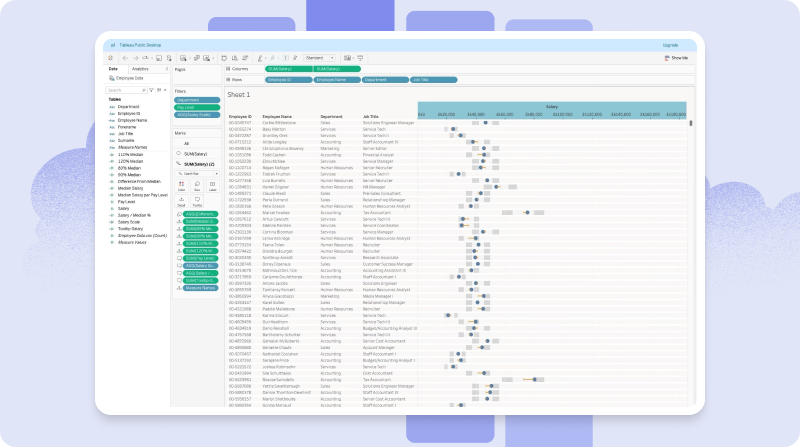
Tableau is a data visualization and analytics platform. Its biggest draw is that users can import raw data and have it transformed into visuals that are easy to understand and use for decision-making. Tableau's drag-and-drop interface means that you don't have to be a coding expert to build visualizations, which is helpful for the less-than-tech-savvy user.
The software also includes tools to help you best utilize data in one central location, including data analysis capabilities and data preparation tools. For example, you can remove duplicates and handle missing values directly within Tableau-- no need to bounce between the software and your original data source.
Tableau customers include familiar names such as Verizon, JetBlue, Cigna, and Whole Foods.
Key Features
- Interactive data visualization: Users can create interactive visualizations of data using charts, graphs, maps, and dashboards. You can import and blend data from multiple sources to create comprehensive datasets to analyze.
- Ready-built templates: Tableau Accelerators are dashboards tailored to help you visualize the specific data set you want to visualize and are designed for a variety of industries and applications. With hundreds to choose from, these templates cover just about everything from recruiting efficiency to supply intelligence.
- Integrations: Tableau has native integrations with Google Sheets, Google Analytics, Oracle, OneDrive, SAP HANA, Microsoft Excel, Slack, and dozens of other programs.
Customer Review From G2
"Tableau distinguishes itself from competing software products on the market today with its wide range of features, which include advanced analytics like predictive modeling and forecasting capabilities as well as natural language query support that enables users to ask questions about their data in plain English rather than by writing code queries. In addition, hundreds of prebuilt templates are available, allowing even inexperienced users to instantly access complex visualizations without any prior design expertise."
2. ActivTrak
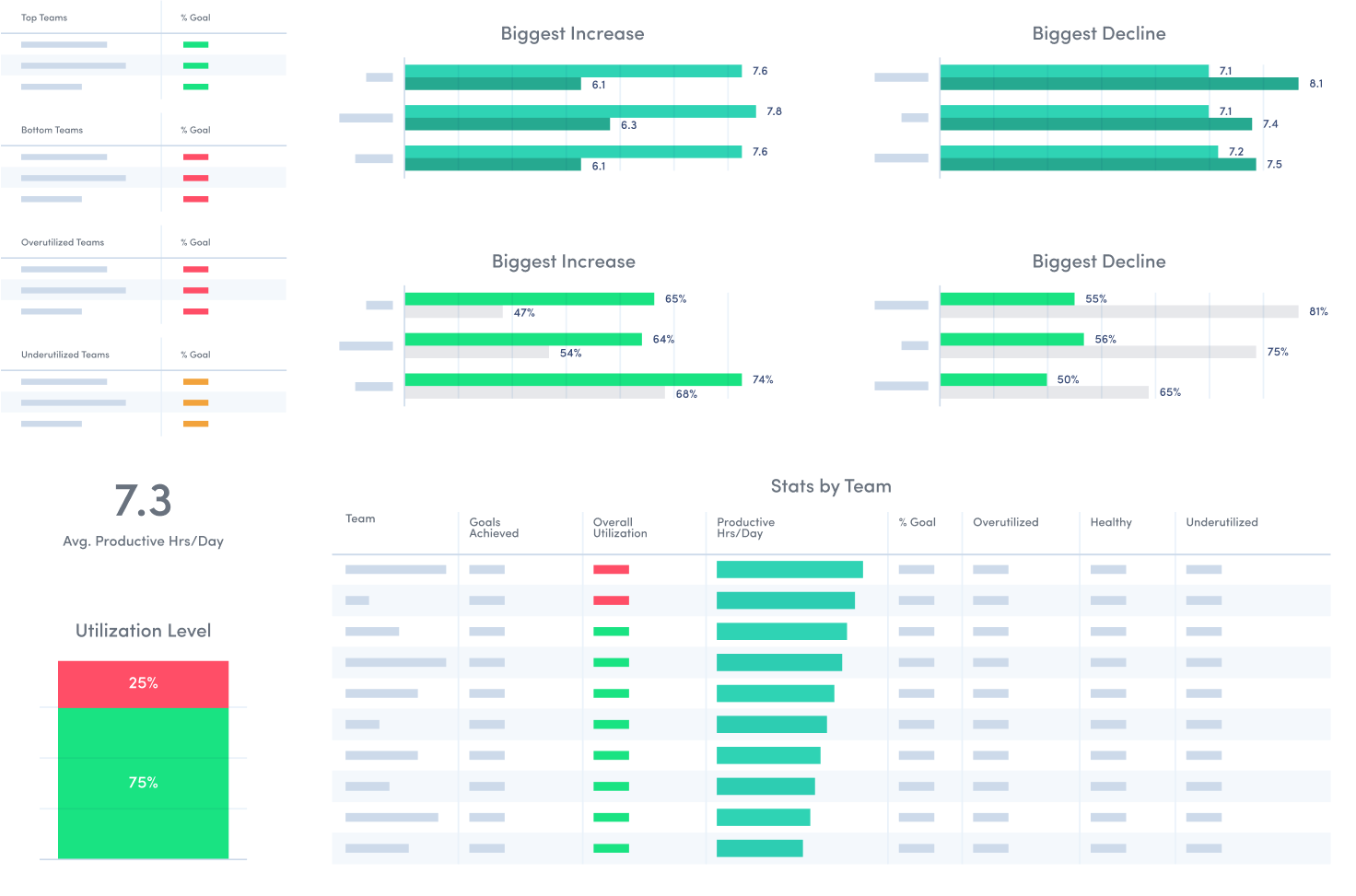
ActivTrak provides insight into employee performance by helping to track digital work activity. Named 'Google Analytics for your office' by one reviewer, the platform helps provide a picture of employee work habits and productivity trends.
Unlike other platforms used for performance management, ActivTrak doesn't log keystrokes or record employees' screens; it detects mouse and keyboard movement and takes screenshots. The data provided by the software can be used to spot signs of burnout and set baselines for employee productivity.
It also offers insights you may not have expected in a tool that evaluates employee activity. For example, the Knowledge Management dashboard notes what searches are being performed by employees and teams, which can indicate gaps in knowledge where employees would benefit from additional training.
ActivTrak emphasizes the point that it's not designed to make employees feel like they're being spied on. Leadership can only see employee data from the people they manage and the Do Not Track feature can be turned on at any time to stop tracking a device.
ActivTrack users include Allstate, Orange Theory, and Fam Brands.
Key Features
- Workflow management: ActivTrak's workflow visibility helps you identify workflow bottlenecks so you can restructure inefficient processes, resulting in better task management and increased productivity.
- Compliance management: Activity alarms can be set up to notify management about certain activities, such as users accessing a certain URL or plugging in a USB device.
- Privacy: With ActivTrak's advanced plan, you can add on the DLP feature to redact sensitive employee information that may be captured in screenshots, such as phone numbers and insurance information.
Customer Review From G2
"With the advent of remote work, it's difficult to get a 360 degree view of how each of our team members spend their days. With ActivTrak - it completes the picture by providing overall summaries as well as fine details for each member. This greatly assists in recognizing our most diligent workers, highlights possible inefficient processes, and also helps with coaching if/as needed."
3. IBM Planning Analytics

IBM Planning Analytics is designed to help organizations with planning, budgeting, forecasting, and data analysis so they can experience better business outcomes. The platform offers interactive dashboards that allow users to explore their data and apply that information to workforce-related decisions. Their website highlights three key features of the software: AI forecasting, a web interface and an Excel interface.
Key Features
- AI forecasting: AI forecasts are integrated into all planning models and automatically update key performance indicators. Use this feature to forecast future trends, identify outliers, and simulate a variety of business scenarios.
- Web interface: Typically referred to as the IBM Planning Analytics Workspace (PAW), this web-based application is where users access and interact with their analysis and reporting data. PAW offers collaboration capabilities so multiple employees can collaborate in real time.
- Excel interface: PAW integrates with Microsoft Excel so you can import and export data between Planning Analytics and Excel. This allows you to use already familiar Excel features to analyze data, create reports, and generate visualizations of your data.
Customer Review From G2
"I use many different analytics tools in my work (Einstein Analytics, Google Data Studio, Tableau, etc.) but IBM has got to be one of the best when it comes to ease of use for both it's admins and it's end-users (viewers only)."
RELATED: 10 Best HRIS Systems List for 2024
4. Visier
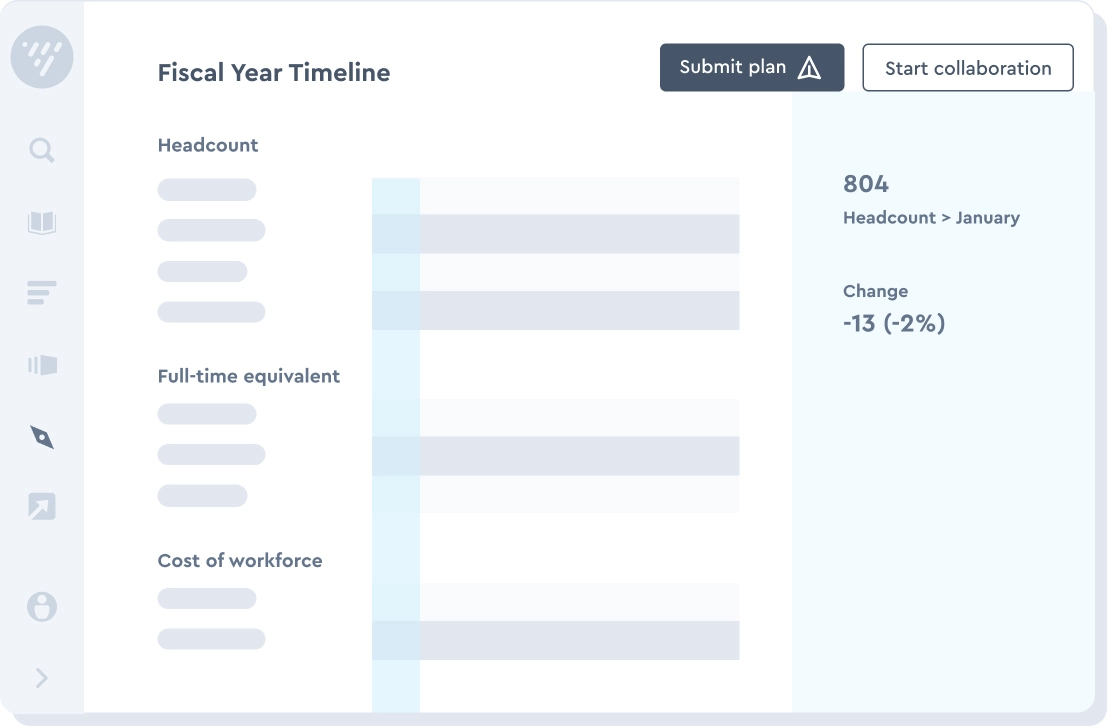
Visier touts itself as a people analytics solution. The platform allows users to collect and assess workforce data from multiple sources such as HRIS systems, payroll systems, and employee surveys. Use the people analytics platform to build effective employee retention programs, improve your compensation strategy, encourage internal mobility, and more. Native integrations include ADP, SAP, Workday, Taleo, and other programs.
Unfortunately, Visier doesn't have a mobile version, so it needs to be accessed on a computer rather than a mobile device.
Key features
- Pre-built analytics: Visier tracks over 2,000 metrics so you can utilize ready-to-use insights like performance metrics, turnover rates, and diversity metrics-- just to name a few. These pre-built people analytics provide valuable insights without the need for extensive and time-consuming data manipulation. For example, Visier measures overtime in order to help prevent employee fatigue and burnout.
- Benchmarking: Users can benchmark workforce metrics against industry benchmarks and competitors. With this data, you can compare your performance to industry standards, identify areas for improvement, and set realistic goals.
- Security management: Visier implements policies and procedures to meet global security, data protection, and data transfer protocols. The company has also designed a Disaster Recovery Plan and Business Continuity Plan to make sure users are still able to access the platform and their data in the event of a disaster.
- Talent management: Visier supports HR throughout the entire employee lifecycle, offering features that help with recruitment, hiring, employee management, and offboarding.
Customer Review From G2:
"Visier allows you to collate HR data from multiple source systems, transform and normalize the data, and produce visually compelling insights that drive data-informed business decisions. Their approach to implementation is centered on maximizing value early on, understanding the customers' business and any targeted business concerns that HR data may support. Visier's security allows the user to share sensitive HR data with the organization at a level of detail appropriate for their business needs. The ease of use strengthens the adoptability and utilization, translating investment dollars into positive ROI."
5. SAP SuccessFactors
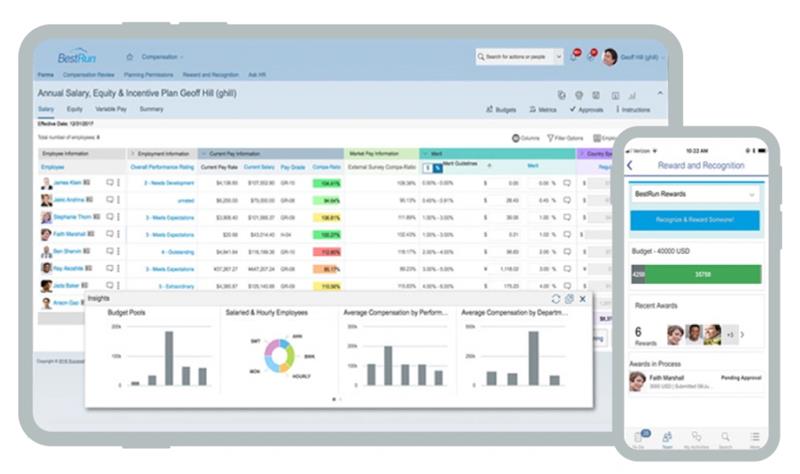
SAP SuccessFactors is a human capital management platform that offers solutions to help you manage your workforce effectively. Familiar customers include Nestle, Microsoft, Asics, and Hanes. However, close to 80% of SAP SuccessFacttors users are small to medium-sized businesses, so the software is suited for organizations of any size.
Key Features
SAP SuccessFactors identifies five areas of business that the software is designed to optimize: Core HR and payroll, talent management, employee experience management, HR analytics and workforce planning, and sales performance management.
The HR analytics and workforce planning aspect offers several features to utilize people analytics in making proactive decisions for your workforce.
- Standard HR analytics catalog: Multiple data sources are integrated so you can analyze all pertinent data in one location. This HR data catalog provides the entire company with a single source of truth so all employees are on the same page.
- Predictive analytics: Forecast future work trends based on historical data. Using statistical algorithms and machine learning techniques, the platform can predict turnover rates, employee shortages, and workforce needs, so you can address hiring gaps before they become a problem.
- Strong security features: SAP SuccessFactors is designed so you can provide access to those who need it (and keep sensitive data away from eyes who shouldn't see it) using security entitlements. Using Cloud Identity Access Governance you can enhance identity and access management and make sure your security practices are always in compliance.
6. Anaplan
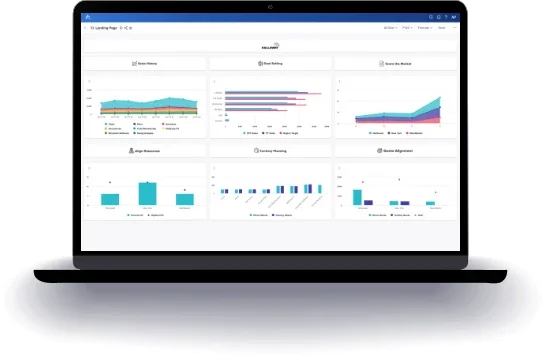
Anaplan is a cloud-based platform that allows businesses to connect data and people in real time. As a unified planning platform, it helps you create a single source of truth for all of your data. This prevents data silos and ensures that all employees are working off the same information and are better prepared to collaborate.
Familiar Anaplan users include L'OREAL, Deloitte, and Novotech.
Key Features
- Iterative forecasting: Predictive insights can help you make data-driven strategic plans to maximize growth. You can plug in hundreds of variables and constraints to decide which direction to go in when faced with challenging scenarios.
- Data integration: Anaplan integrates with ERP systems, CRM systems, and financial databases so you can utilize your existing databases. Anaplan's extensibility utilizes a three-pronged approach.
-
- Connectors link to third-party services to automate data imports and exports. This includes tools such as Salesforce, NetSuite, Oracle, OneCloud, DocuSign, Microsoft Power BI, and more.
- Integrations allow you to combine data from multiple sources so you can utilize all of your data in a single platform.
- Web scripts, tools, and APIs can be used to gather additional insights about your data.
- Performance management and analytics: These capabilities allow you to monitor and measure performance against strategic objectives and KPIs. Dashboards, reports, and scorecards are available to help you visualize key metrics and track progress toward goals.
Customer Review From G2
"We use Anaplan across Finance, HR, Sales, etc. and across multiple regions. Our legacy systems were mostly in silos and/or offline which makes it very challenging to have a consistent view at one place for planning. Anaplan provides a platform as one-place to go for planning and analytics, improving planning efficiency."
7. Oracle Analytics Cloud

Oracle Analytics Cloud is a comprehensive analytics platform that can be used for data analysis, visualization, and insights. Within Oracle Analytics is Oracle Fusion HCM Analytics: a solution that's designed to help HR teams leverage data to make confident decisions.
Key Features
- Workforce management: Using Oracle Cloud HCM you can gain a comprehensive overview of your workforce. It helps you look at metrics such as team effectiveness, headcount movement, and absence data.
- Diversity and inclusion: Oracle Cloud HCM can be used to improve your DEI initiatives. Use it to monitor metrics such as employee nationalities and ethnicities, your manager gender ratio, and how many workers are above the age of 60. This data can help you achieve greater hiring equity and identify hiring and promotion biases.
- Oracle Mobile App: The Oracle app allows users to access their data while on the go. It offers a unique podcast feature that allows you to request a podcast-like overview detailing trends, changes, and highlights of your data. It can also be set to deliver alerts based on specific triggers such as when you arrive at a certain GPS location or new data becomes available.
- Data storytelling: Oracle offers the standard data visualizations such as charts and graphs, as well as advanced visualizations like heat map and treemaps. The software offers the option to create composite visualizations that combine multiple visuals in a single chart so that you can see correlations in the data and identify trends that might have easily been missed.
Customer Review From G2
"What I like most about Oracle Analytics Cloud is its analytics capabilities and ease of use. It provides advanced capabilities such as automatic data planning and predictive analytics, all integrated with the Oracle ecosystem. Additionally, its scalability, performance, and focus on security make it an excellent choice for organizations of all sizes."
8. ADP Workforce
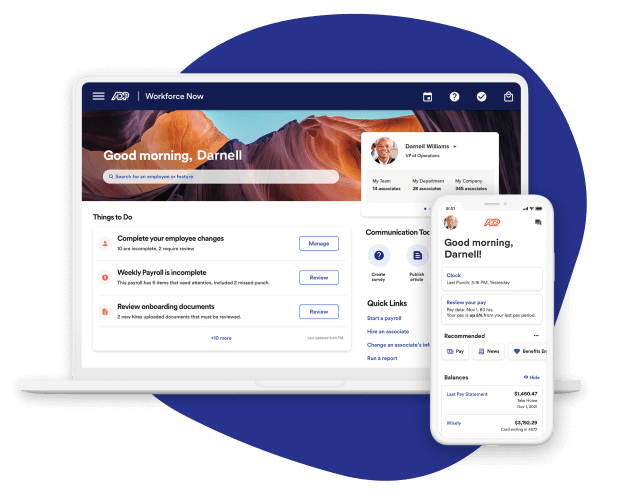
ADP Workforce is a human capital management platform that offers a variety of workforce management capabilities. The ADP DataCloud helps identify patterns and trends in your HR data. Its metrics look at employee compensation, recruitment, attendance, employee turnover, performance, diversity, and a number of other areas, in order to help you create actionable insights that can be used for data-driven decision-making.
Key Features
- Analytics dashboards: Interactive dashboards can provide data-driven insights into trends and patterns. Pre-built dashboards include visuals to help you understand your workforce data, and you can customize your dashboard to focus on which data insights are most relevant.
- Data management: Workforce functions as a single source of truth for all of your people data, including employee demographics, payroll, performance evaluations, attendance records, and more.
- Benchmarking: ADP DataCloud maintains up-to-date data from its client base which includes more than 30 million employees. You can use this data to see how your compensation, employee tenure, and additional HR metrics stack up against others in your industry and geographic area.
Customer Review From G2
"The sheer volume of reporting capabilities is endless! I love analytics, and I have not found one instance where I was not able to get the information I needed out of the system exactly how I needed it."
9. WorkForce Software
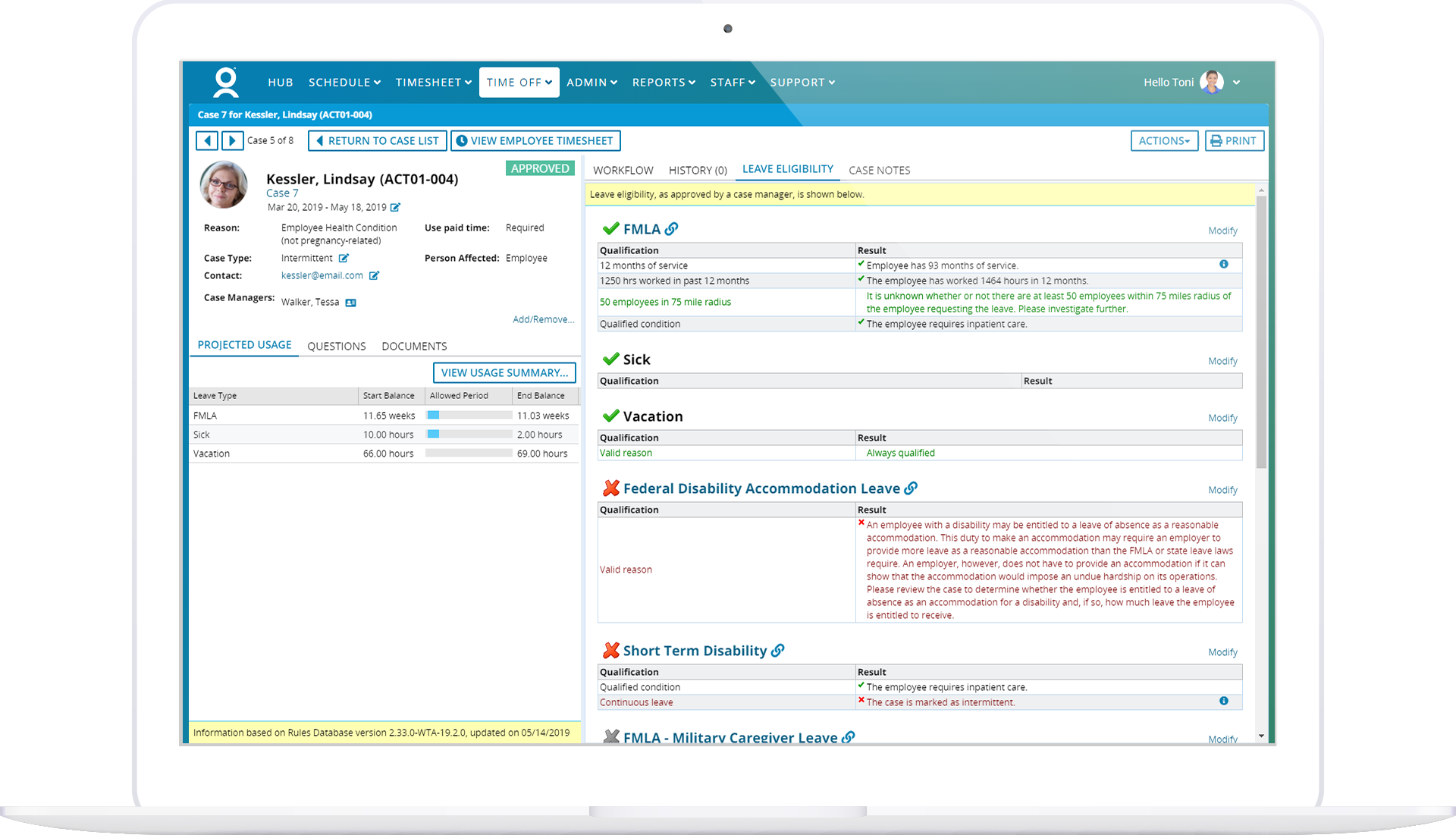
WorkForce Software is a workforce management platform designed to help optimize your workforce and improve operational efficiency. The WorkForce Suite includes functions for data capture, analytics and insights, scheduling, employee productivity, and more.
Key Features
- Proactive notifications: WorkForce sends alerts about time-sensitive issues that might otherwise be overlooked, such as last-minute scheduling needs or compliance violations that should be immediately addressed.
- Labor forecasting and planning: WorkForce Software offers labor forecasting and planning functions that help you predict future needs and optimize resource allocation so you have the right number of employees in the right departments. It also uses this data to help develop optimized employee schedules.
Are You Utilizing Software to Boost Employee Engagement?
While workforce analytics software is important, in order for companies to reach their full potential, they need a holistic approach to the employee experience -That's where Terryberry comes in.
Our configurable program lets you start small and dream big. Begin with what you need now, with the flexibility to build more as your engagement and recognition goals evolve. Craft the perfect mix of employee surveys, recognition, rewards, swag, step challenges, and wellness programs - all in one place.
See for yourself. Schedule a demo with one of our experts to see firsthand how Terryberry can transform your employee engagement with one powerful platform.

